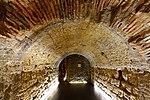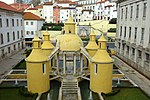Roman Catholic Diocese of Coimbra
CoimbraRoman Catholic Ecclesiastical Province of BragaRoman Catholic dioceses in Portugal

The Diocese of Coimbra (Latin: Dioecesis Conimbricensis) is a Roman Catholic diocese in Coimbra, Portugal. It is a suffragan of the Archdiocese of Braga.From 1472, the bishop of Coimbra held the comital title of Count of Arganil, being thus called Bishop-Count (Portuguese: Bispo-Conde).
Excerpt from the Wikipedia article Roman Catholic Diocese of Coimbra (License: CC BY-SA 3.0, Authors, Images).Roman Catholic Diocese of Coimbra
Rua da Ilha, Coimbra Alta (Coimbra (Sé Nova, Santa Cruz, Almedina e São Bartolomeu))
Geographical coordinates (GPS) Address Nearby Places Show on map
Geographical coordinates (GPS)
| Latitude | Longitude |
|---|---|
| N 40.2088 ° | E -8.4271 ° |
Address
Igreja da Sé Velha
Rua da Ilha
3000-383 Coimbra, Alta (Coimbra (Sé Nova, Santa Cruz, Almedina e São Bartolomeu))
Portugal
Open on Google Maps










